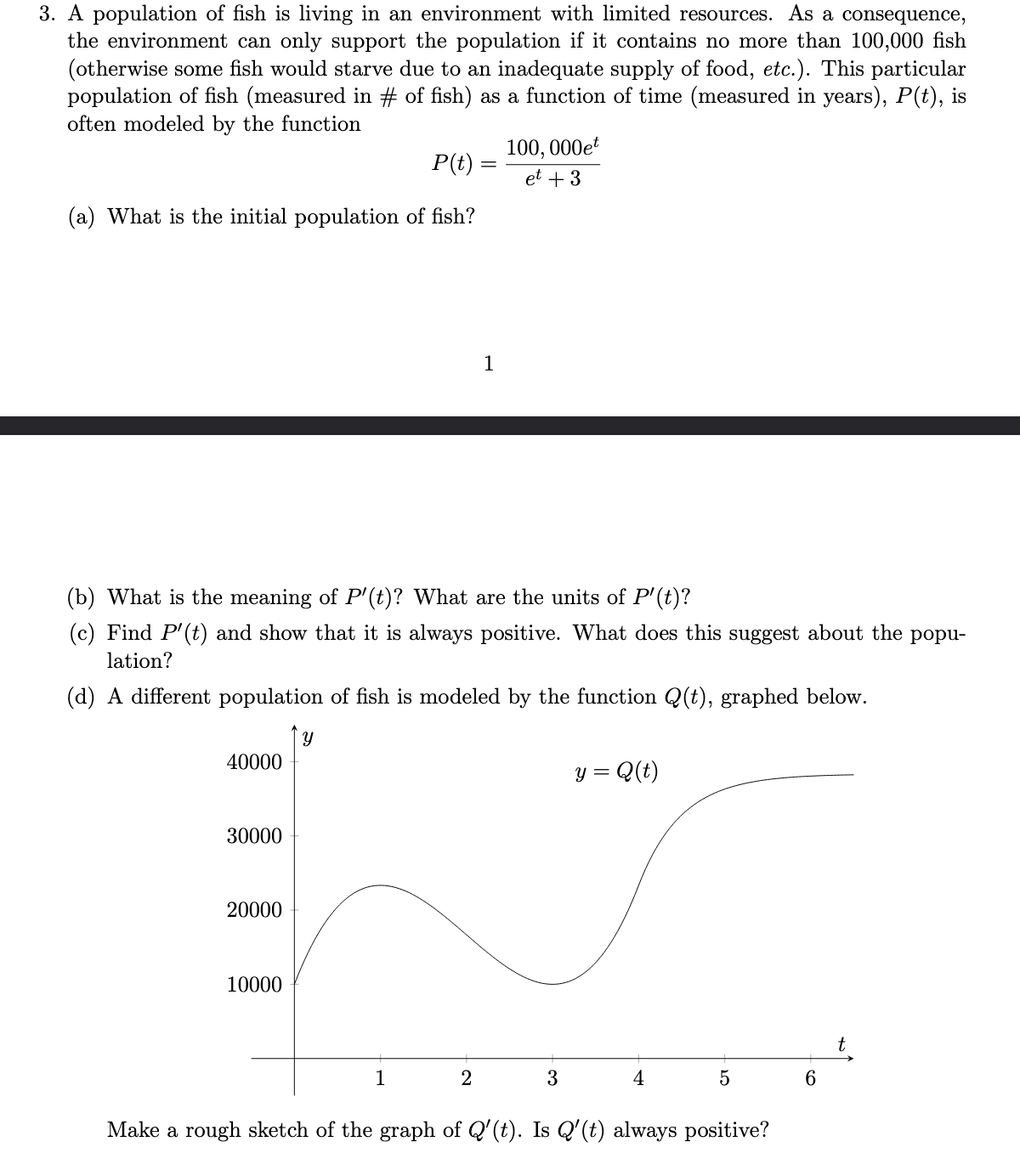3. A population of fish is living in an environment with limited resources. As a consequence, the environment can only support the population if it contains no more than 100,000 fish (otherwise some fish would starve due to an inadequate supply of food, etc.). This particular population of fish (measured in # of fish) as a function of time (measured in years), P(t), is often modeled by the function 100, 000et et + 3 P(t) = (a) What is the initial population of fish? 1 (b) What is the meaning of P'(t)? What are the units of P'(t)? (c) Find P'(t) and show that it is always positive. What does this suggest about the popu- lation?
3. A population of fish is living in an environment with limited resources. As a consequence, the environment can only support the population if it contains no more than 100,000 fish (otherwise some fish would starve due to an inadequate supply of food, etc.). This particular population of fish (measured in # of fish) as a function of time (measured in years), P(t), is often modeled by the function 100, 000et et + 3 P(t) = (a) What is the initial population of fish? 1 (b) What is the meaning of P'(t)? What are the units of P'(t)? (c) Find P'(t) and show that it is always positive. What does this suggest about the popu- lation?
College Algebra
7th Edition
ISBN:9781305115545
Author:James Stewart, Lothar Redlin, Saleem Watson
Publisher:James Stewart, Lothar Redlin, Saleem Watson
Chapter2: Functions
Section: Chapter Questions
Problem 30P: In this problem you are asked to find a function that models in real life situation and then use the...
Related questions
Question

Transcribed Image Text:3. A population of fish is living in an environment with limited resources. As a consequence,
the environment can only support the population if it contains no more than 100,000 fish
(otherwise some fish would starve due to an inadequate supply of food, etc.). This particular
population of fish (measured in # of fish) as a function of time (measured in years), P(t), is
often modeled by the function
100, 000et
P(t)
et +3
(a) What is the initial population of fish?
1
(b) What is the meaning of P'(t)? What are the units of P'(t)?
(c) Find P'(t) and show that it is always positive. What does this suggest about the popu-
lation?
(d) A different population of fish is modeled by the function Q(t), graphed below.
40000
y = Q(t)
30000
20000
10000
1
2
4
5
6.
Make a rough sketch of the graph of Q'(t). Is Q'(t) always positive?
Expert Solution
This question has been solved!
Explore an expertly crafted, step-by-step solution for a thorough understanding of key concepts.
This is a popular solution!
Trending now
This is a popular solution!
Step by step
Solved in 2 steps with 2 images

Knowledge Booster
Learn more about
Need a deep-dive on the concept behind this application? Look no further. Learn more about this topic, calculus and related others by exploring similar questions and additional content below.Recommended textbooks for you

College Algebra
Algebra
ISBN:
9781305115545
Author:
James Stewart, Lothar Redlin, Saleem Watson
Publisher:
Cengage Learning

Algebra & Trigonometry with Analytic Geometry
Algebra
ISBN:
9781133382119
Author:
Swokowski
Publisher:
Cengage

College Algebra
Algebra
ISBN:
9781305115545
Author:
James Stewart, Lothar Redlin, Saleem Watson
Publisher:
Cengage Learning

Algebra & Trigonometry with Analytic Geometry
Algebra
ISBN:
9781133382119
Author:
Swokowski
Publisher:
Cengage